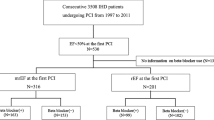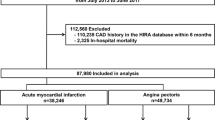Abstract
The current guidelines for acute myocardial infarction (AMI) recommended that β-blocker should be used in patients with decreased left ventricular (LV) systolic function for long-term period. However, the effect of β-blocker in AMI patients with preserved LV systolic function is uncertain. We sought to assess the long-term effect of β-blocker in AMI patients with preserved LV systolic function. During the follow-up period (1997–2011), total 3508 patients were performed percutaneous coronary intervention (PCI). Of these patients, 424 AMI patients with preserved LV systolic function [ejection fraction (EF) > 40 %] were analyzed. Median follow-up period was 4.7 years. Then, patients were divided into two groups (β-blocker group 197 patients and no-β-blocker group 227 patients). However, there are substantial differences in baseline characteristics between two groups. Therefore, we calculated propensity score to match the patients in β-blocker and no-β-blocker groups. After post-match patients (N = 206, 103 matched pair), β-blocker therapy significantly reduced cardiac death compared with no-β-blocker [hazard ratio (HR) 0.40, p = 0.04], whereas β-blocker therapy was not associated with major adverse cardiac events (MACE) and all-cause death. β-Blocker is an effective treatment for AMI patients who underwent PCI with preserved LV systolic function.


Similar content being viewed by others
References
Snow PJ (1965) Effect of propranolol in myocardial infarction. Lancet 2:551–553
(1981) Timolol-induced reduction in mortality and reinfarction in patients surviving acute myocardial infarction. N Engl J Med 304:801–807
(1982) A randomized trial of propranolol in patients with acute myocardial infarction. I. Mortality results. JAMA 247:1707–1714
Ryan TJ, Anderson JL, Antman EM, Braniff BA, Brooks NH, Califf RM, Hillis LD, Hiratzka LF, Rapaport E, Riegel BJ, Russell RO, Smith EE Jr, Weaver WD (1996) ACC/AHA guidelines for the management of patients with acute myocardial infarction. A report of the American College of Cardiology/American Heart Association Task Force on Practice Guidelines (Committee on Management of Acute Myocardial Infarction). J Am Coll Cardiol 28:1328–1428
Van de Werf F, Ardissino D, Betriu A, Cokkinos DV, Falk E, Fox KA, Julian D, Lengyel M, Neumann FJ, Ruzyllo W, Thygesen C, Underwood SR, Vahanian A, Verheugt FW, Wijns W (2003) Management of acute myocardial infarction in patients presenting with ST-segment elevation. The task force on the management of acute myocardial infarction of the European Society of Cardiology. Eur Heart J 24:28–66
Kernis SJ, Harjai KJ, Stone GW, Grines LL, Boura JA, O’Neill WW, Grines CL (2004) Does beta-blocker therapy improve clinical outcomes of acute myocardial infarction after successful primary angioplasty? J Am Coll Cardiol 43:1773–1779
Antman EM, Anbe DT, Armstrong PW, Bates ER, Green LA, Hand M, Hochman JS, Krumholz HM, Kushner FG, Lamas GA, Mullany CJ, Ornato JP, Pearle DL, Sloan MA, Smith SC Jr, Alpert JS, Anderson JL, Faxon DP, Fuster V, Gibbons RJ, Gregoratos G, Halperin JL, Hiratzka LF, Hunt SA, Jacobs AK (2004) ACC/AHA guidelines for the management of patients with ST-elevation myocardial infarction: a report of the American College of Cardiology/American Heart Association Task Force on Practice Guidelines (Committee to Revise the 1999 Guidelines for the Management of Patients with Acute Myocardial Infarction). Circulation 110:e82–e292
Smith SC Jr, Benjamin EJ, Bonow RO, Braun LT, Creager MA, Franklin BA, Gibbons RJ, Grundy SM, Hiratzka LF, Jones DW, Lloyd-Jones DM, Minissian M, Mosca L, Peterson ED, Sacco RL, Spertus J, Stein JH, Taubert KA (2011) AHA/ACCF secondary prevention and risk reduction therapy for patients with coronary and other atherosclerotic vascular disease: 2011 update: a guideline from the American Heart Association and American College of Cardiology Foundation. Circulation 124:2458–2473
Steg PG, James SK, Atar D, Badano LP, Blomstrom-Lundqvist C, Borger MA, Di Mario C, Dickstein K, Ducrocq G, Fernandez-Aviles F, Gershlick AH, Giannuzzi P, Halvorsen S, Huber K, Juni P, Kastrati A, Knuuti J, Lenzen MJ, Mahaffey KW, Valgimigli M, Van ‘t Hof A, Widimsky P, Zahger D (2012) ESC Guidelines for the management of acute myocardial infarction in patients presenting with ST-segment elevation. Eur Heart J 33:2569–2619
O’Gara PT, Kushner FG, Ascheim DD, Casey DE Jr, Chung MK, de Lemos JA, Ettinger SM, Fang JC, Fesmire FM, Franklin BA, Granger CB, Krumholz HM, Linderbaum JA, Morrow DA, Newby LK, Ornato JP, Ou N, Radford MJ, Tamis-Holland JE, Tommaso CL, Tracy CM, Woo YJ, Zhao DX, Anderson JL, Jacobs AK, Halperin JL, Albert NM, Brindis RG, Creager MA, DeMets D, Guyton RA, Hochman JS, Kovacs RJ, Ohman EM, Stevenson WG, Yancy CW (2013) 2013 ACCF/AHA guideline for the management of ST-elevation myocardial infarction: a report of the American College of Cardiology Foundation/American Heart Association Task Force on Practice Guidelines. Circulation 127:e362–e425
Yang JH, Hahn JY, Song YB, Choi SH, Choi JH, Lee SH, Kim JH, Ahn YK, Jeong MH, Choi DJ, Park JS, Kim YJ, Park HS, Han KR, Rha SW, Gwon HC (2014) Association of beta-blocker therapy at discharge with clinical outcomes in patients with ST-segment elevation myocardial infarction undergoing primary percutaneous coronary intervention. JACC Cardiovasc Interv 7:592–601
Choo EH, Chang K, Ahn Y, Jeon DS, Lee JM, Kim DB, Her SH, Park CS, Kim HY, Yoo KD, Jeong MH, Seung KB (2014) Benefit of beta-blocker treatment for patients with acute myocardial infarction and preserved systolic function after percutaneous coronary intervention. Heart 100:492–499
Nakatani D, Sakata Y, Suna S, Usami M, Matsumoto S, Shimizu M, Hara M, Uematsu M, Fukunami M, Hamasaki T, Sato H, Hori M, Komuro I (2013) Impact of beta blockade therapy on long-term mortality after ST-segment elevation acute myocardial infarction in the percutaneous coronary intervention era. Am J Cardiol 111:457–464
Thygesen K, Alpert JS, White HD, Jaffe AS, Apple FS, Galvani M, Katus HA, Newby LK, Ravkilde J, Chaitman B, Clemmensen PM, Dellborg M, Hod H, Porela P, Underwood R, Bax JJ, Beller GA, Bonow R, Van der Wall EE, Bassand JP, Wijns W, Ferguson TB, Steg PG, Uretsky BF, Williams DO, Armstrong PW, Antman EM, Fox KA, Hamm CW, Ohman EM, Simoons ML, Poole-Wilson PA, Gurfinkel EP, Lopez-Sendon JL, Pais P, Mendis S, Zhu JR, Wallentin LC, Fernandez-Aviles F, Fox KM, Parkhomenko AN, Priori SG, Tendera M, Voipio-Pulkki LM, Vahanian A, Camm AJ, De Caterina R, Dean V, Dickstein K, Filippatos G, Funck-Brentano C, Hellemans I, Kristensen SD, McGregor K, Sechtem U, Silber S, Widimsky P, Zamorano JL, Morais J, Brener S, Harrington R, Morrow D, Lim M, Martinez-Rios MA, Steinhubl S, Levine GN, Gibler WB, Goff D, Tubaro M, Dudek D, Al-Attar N (2007) Universal definition of myocardial infarction. Circulation 116:2634–2653
Jaffe AS, Ravkilde J, Roberts R, Naslund U, Apple FS, Galvani M, Katus H (2000) It’s time for a change to a troponin standard. Circulation 102:1216–1220
Cannon CP, Brindis RG, Chaitman BR, Cohen DJ, Cross JT Jr, Drozda JP Jr, Fesmire FM, Fintel DJ, Fonarow GC, Fox KA, Gray DT, Harrington RA, Hicks KA, Hollander JE, Krumholz H, Labarthe DR, Long JB, Mascette AM, Meyer C, Peterson ED, Radford MJ, Roe MT, Richmann JB, Selker HP, Shahian DM, Shaw RE, Sprenger S, Swor R, Underberg JA, Van de Werf F, Weiner BH, Weintraub WS (2013) 2013 ACCF/AHA key data elements and definitions for measuring the clinical management and outcomes of patients with acute coronary syndromes and coronary artery disease: a report of the American College of Cardiology Foundation/American Heart Association Task Force on Clinical Data Standards (Writing Committee to Develop Acute Coronary Syndromes and Coronary artery Disease Clinical Data Standards). Circulation 127:1052–1089
Austin PC, Mamdani MM (2006) A comparison of propensity score methods: a case-study estimating the effectiveness of post-AMI statin use. Stat Med 25:2084–2106
Normand ST, Landrum MB, Guadagnoli E, Ayanian JZ, Ryan TJ, Cleary PD, McNeil BJ (2001) Validating recommendations for coronary angiography following acute myocardial infarction in the elderly: a matched analysis using propensity scores. J Clin Epidemiol 54:387–398
Freemantle N, Cleland J, Young P, Mason J, Harrison J (1999) Beta blockade after myocardial infarction: systematic review and meta regression analysis. BMJ 318:1730–1737
Ikuta S, Kobuke K, Iwanaga Y, Nakauchi Y, Yamaji K, Miyazaki S (2014) Difference in neointimal coverage at chronic stage between bare metal stent and sirolimus-eluting stent evaluated at stent-strut level by optical coherence tomography. Heart Vessels 29:320–327
Nakayama A, Morita H, Ando J, Fujita H, Ohtsu H, Nagai R (2013) Adverse cardiovascular outcomes associated with concurrent use of clopidogrel or ticlopidine and proton-pump inhibitors in patients undergoing percutaneous coronary intervention. Heart Vessels 28:292–300
Kezerashvili A, Marzo K, De Leon J (2012) Beta blocker use after acute myocardial infarction in the patient with normal systolic function: when is it “ok” to discontinue? Curr Cardiol Rev 8:77–84
JCS Joint Working Group (2013) Guidelines for secondary prevention of myocardial infarction (JCS 2011). Circ J 77:231–248
Ozasa N, Kimura T, Morimoto T, Hou H, Tamura T, Shizuta S, Nakagawa Y, Furukawa Y, Hayashi Y, Nakao K, Matsuzaki M, Nobuyoshi M, Mitsudo K (2010) Lack of effect of oral beta-blocker therapy at discharge on long-term clinical outcomes of ST-segment elevation acute myocardial infarction after primary percutaneous coronary intervention. Am J Cardiol 106:1225–1233
Olsson G, Rehnqvist N, Lundman T, Melcher A (1981) Metoprolol treatment after acute myocardial infarction. Effects on ventricular arrhythmias and exercise tests during 6 months. Acta Med Scand 210:59–65
Friedman LM, Byington RP, Capone RJ, Furberg CD, Goldstein S, Lichstein E (1986) Effect of propranolol in patients with myocardial infarction and ventricular arrhythmia. J Am Coll Cardiol 7:1–8
McMurray J, Kober L, Robertson M, Dargie H, Colucci W, Lopez-Sendon J, Remme W, Sharpe DN, Ford I (2005) Antiarrhythmic effect of carvedilol after acute myocardial infarction: results of the carvedilol post-infarct survival control in left ventricular dysfunction (capricorn) trial. J Am Coll Cardiol 45:525–530
Heidland UE, Strauer BE (2001) Left ventricular muscle mass and elevated heart rate are associated with coronary plaque disruption. Circulation 104:1477–1482
Dutta P, Courties G, Wei Y, Leuschner F, Gorbatov R, Robbins CS, Iwamoto Y, Thompson B, Carlson AL, Heidt T, Majmudar MD, Lasitschka F, Etzrodt M, Waterman P, Waring MT, Chicoine AT, van der Laan AM, Niessen HW, Piek JJ, Rubin BB, Butany J, Stone JR, Katus HA, Murphy SA, Morrow DA, Sabatine MS, Vinegoni C, Moskowitz MA, Pittet MJ, Libby P, Lin CP, Swirski FK, Weissleder R, Nahrendorf M (2012) Myocardial infarction accelerates atherosclerosis. Nature 487:325–329
Acknowledgments
This study was supported by grant-in aid for scientific research from Ministry of Health, Labour and Welfare (23591063). We greatly acknowledge the contributions made by Ms. Yumi Nozawa and Ms. Ayako Onodera for data collection and managements.
Conflict of interest
The authors declare that there is no conflict of interest.
Ethical standards
Ethics approval was obtained from Juntendo University ethics committee.
Author information
Authors and Affiliations
Corresponding author
Rights and permissions
About this article
Cite this article
Konishi, H., Miyauchi, K., Kasai, T. et al. Long-term effect of β-blocker in ST-segment elevation myocardial infarction in patients with preserved left ventricular systolic function: a propensity analysis. Heart Vessels 31, 441–448 (2016). https://doi.org/10.1007/s00380-014-0624-2
Received:
Accepted:
Published:
Issue Date:
DOI: https://doi.org/10.1007/s00380-014-0624-2




